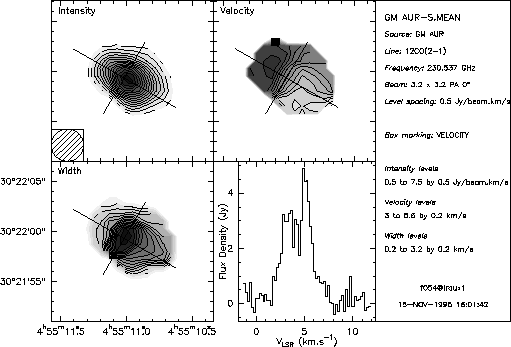




Figure: The proto-planetary disk around the T Tauri star GM Aur, observed with
the Plateau de Bure interferometer on Nov 9, 1995 (1.5 hours of
integration).
Figure 4 is a result of observations at 230 GHz obtained
on Nov 9, 1995.
The array was in the most compact configuration (baselines from
24 to 64 meters), which already gives about  resolution at the
CO J=2-1 frequency. The figure shows images of
the integrated intensity of the CO J=2-1 line, of the velocity field and
of the line width of a proto-planetary disk around the T Tauri star GM Aur.
The integrated spectrum is also shown. The data were obtained in
snapshot mode (4 sources were observed during the same transit),
so that the total integration time on source is less than 1.5 hours.
resolution at the
CO J=2-1 frequency. The figure shows images of
the integrated intensity of the CO J=2-1 line, of the velocity field and
of the line width of a proto-planetary disk around the T Tauri star GM Aur.
The integrated spectrum is also shown. The data were obtained in
snapshot mode (4 sources were observed during the same transit),
so that the total integration time on source is less than 1.5 hours.
Keplerian rotation had been previously detected by aperture synthesis
observations of  CO J=2-1 performed at OVRO
(Koerner, Sargent & Beckwith
1993, Icarus 106, 2), with an angular resolution of
CO J=2-1 performed at OVRO
(Koerner, Sargent & Beckwith
1993, Icarus 106, 2), with an angular resolution of  by
by  .
Despite the very short integration time, the Plateau de Bure data
significantly improve the angular resolution and unambiguously
confirm the Keplerian rotation.
.
Despite the very short integration time, the Plateau de Bure data
significantly improve the angular resolution and unambiguously
confirm the Keplerian rotation.
Stéphane GUILLOTEAU